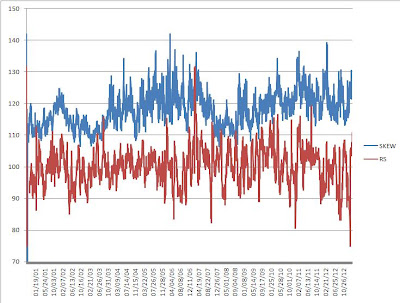Volatility at World's End: Two Decades of Movement
Saturday, March 30, 2013
2 Decades of SPX Vols
Despite that this is only up to 2011, it gives a pretty feel for SPX vol term structure and is a beautiful work of art from Artemis Capital Management.
Volatility at World's End: Two Decades of Movement
Volatility at World's End: Two Decades of Movement
Tuesday, March 26, 2013
Easy portfolio setup for a 2.37 Sharpe Ratio
The CBOE VARB-X (Volatility Arbitrage) Strategy Benchmark has reached a Sharpe ratio of 2.37-- significantly greater than the Sharpe Ratio for the S&P 500 for the same time period, as seen in the below graph.
* Technically it is more of a statistical arbitrage, since it's an unhedged bet, though with a very positive expectation.
Some basic relative performance stats for the period:
It is simple to replicate, by following the setup described in the Strategy Benchmark Paper.
1) Keep 80% of the portfolio cash.
2) Short and hold Variance Futures, roll with each expiration.
Ways to avoid the volatility spikes (drawdowns)
1) Apply a volatility filter
2) Use volatility forecasts for position size adjustment. You can do this in Excel, or off a 3rd party such as NYU V-Lab
* Technically it is more of a statistical arbitrage, since it's an unhedged bet, though with a very positive expectation.
Some basic relative performance stats for the period:
| |||||||||||
It is simple to replicate, by following the setup described in the Strategy Benchmark Paper.
1) Keep 80% of the portfolio cash.
2) Short and hold Variance Futures, roll with each expiration.
Ways to avoid the volatility spikes (drawdowns)
1) Apply a volatility filter
2) Use volatility forecasts for position size adjustment. You can do this in Excel, or off a 3rd party such as NYU V-Lab
Thursday, March 21, 2013
Gamma/Theta Relationship for FX Options
I approach expected option PnL (Profit & Loss) from a holistic approach. Similar to the former post on Expected PnL, i.e. E(PnL) of delta hedged stock options (link), here is the basic estimate for the 24hour E(PnL) for delta neutral FX Options:
Source: Foreign Exchange Derivatives: Advanced Hedging and Trading Techniques
(You're welcome)
Given the following variable definitions:
Sigma: Average Realized Volatility for the life of the trade
S: Underlying FX spot value
Gamma: Option Gamma
r(d): Domestic risk free rate
r(f): Foreign risk free rate
Delta: Option delta
Theta: Option Theta
V: Value of Options (straddles, strangles, etc.)
So how do we use this?
Estimate a RANGE of the coming day's estimated realized vol, and you would find the rough break-even, most-likely points of E(PnL).
Source: Foreign Exchange Derivatives: Advanced Hedging and Trading Techniques
(You're welcome)
Given the following variable definitions:
Sigma: Average Realized Volatility for the life of the trade
S: Underlying FX spot value
Gamma: Option Gamma
r(d): Domestic risk free rate
r(f): Foreign risk free rate
Delta: Option delta
Theta: Option Theta
V: Value of Options (straddles, strangles, etc.)
So how do we use this?
Estimate a RANGE of the coming day's estimated realized vol, and you would find the rough break-even, most-likely points of E(PnL).
Tuesday, March 19, 2013
What's the deal with Barrier Options?
Barrier
options offer several interesting benefits to professional traders with increased
cost-effectiveness and complex hedging needs, and they can be statically
replicated with vanilla options.
Today we look at the basic payoff structure of an “up-and-out
Call”, and replication with vanilla options so to avoid OTC transactions.
Payoff structure of an Up-and-Out Call Option
Examples are from Static Options Replication by Derman, Ergene, and Kani.
Given that
We get the following option values
Payoff structure of an Up-and-Out Call Option
Examples are from Static Options Replication by Derman, Ergene, and Kani.
Given that
|
Underlying
|
100
|
|
Strike
|
100
|
|
Barrier
|
120
|
|
Rebate
|
0
|
|
Time to
Expiration
|
1 Year
|
|
Dividend
Yield
|
5%
|
|
Expected
Volatility
|
25%
|
|
Risk-Free
Rate
|
10%
|
We get the following option values
|
Up-and-Out
Call
|
0.656
|
|
Vanilla
Call
|
0.114
|
Payoff
diagram
Replication with vanilla options
The key to replication is about matching theoretical payoffs
at various future underlying values so that the portfolio behaves like the
barrier option. See the Goldman Sachs Research Note for detailed notes. I will leave the
replication for the example Up-and-Out Call here,
|
Quantity
|
Strike
|
Expiration
|
Values
|
|
0.16253
|
120
|
2
|
0.0001
|
|
0.25477
|
120
|
4
|
0.018
|
|
0.44057
|
120
|
6
|
0.106
|
|
0.93082
|
120
|
8
|
0.455
|
|
2.79028
|
120
|
10
|
2.175
|
|
-6.51351
|
120
|
12
|
-7.14
|
|
1
|
100
|
12
|
6.67
|
|
Total
Cost
|
2.284
|
Saturday, March 16, 2013
High Liquidity ~ High Efficiency (not good for trading)
Financial products of very high liquidity are often unfavorable by professional traders, mainly due to increased price
efficiency. I am going to point out a few ideas on why this may be so from
personal experience. I may be wrong, and would welcome any contrasting ideas,
as long as we all end up learning something contributing to larger trading
profits going forward.
Benefits from high liquidity
High liquidity implies lower transaction costs for exchange
participants who engage in purely liquidity-taking executions. This segment of
participants includes the following segments:
1)
New traders, often with no positive expected alpha
2)
Buy & hold funds, with no positive expected alpha
3)
Short & hold funds, with no expected alpha in the
short term
4)
Pure/Statistical
Arbitrageurs, who generate almost purely alpha, and
depend on multiple executions simultaneously.
* OTC (Over
The Counter) products such as spot FX,
CFDs,
or CDS
do not always offer lower transaction costs despite high liquidity.
So having high liquidity is great, right? Let’s see how that
might not be the case.
Liquidity and level
of competition
Exchange traded
products of high liquidity usually indicates an increased number of smarter, significantly
capitalized competition who specialize in liquidity provision and short term
alpha. This group of participants is usually institutional in nature, full of
very smart analysts and traders working to squeeze every penny out of any
inefficiency available.
A more efficient market system is undesirable for less
capitalized professional, private traders. Using poker as an analogy, you are
expected to make more money playing against newbies than a table full of pros.
Low to mid liquidity
conditions, opportunities
From my experience with exchange traded derivatives, a lot
of “easier” money making opportunities tend to arise in periods of low
liquidity. Here are some examples of opportunities available only in periods,
products of relatively low liquidity:
1) Liquidity Provision: Make the market, and get that wider
bid/offer spreads from careless, desperate traders who close their eyes, hit
the market, and hope for the best. Some exchanges offer a rebate for liquidity provision orders, as a bonus.
2) Pure arbitrage: Different derivative contracts of identical
underlying products get out of line against fair values more easily with
respect to supply and demand.
Many other forms of price inefficiency exist in low, mid
liquidity exchange traded products, it only takes a bit of digging to find them.
Basically, low liquidity ~ more exploitable inefficiencies. It may be counter
intuitive, but makes sense right?
Wednesday, March 13, 2013
Why I avoid web based analysis content
Just came across the story of Andy Zaky, the internet-educated investment advisor at seeking-alpha, who led a good number of investors down a road of heavy losses off the AAPL dip. While some may choose to crucify Zaky, his followers were largely victims of their personal resistance toward critical thinking.
Reality of most Internet analysis content
The fact remains,
those who make a living off analysis do so because up to this point, they have
not been able to make more off actual trading. I have met traders/fund managers with more experience who really have little idea of how to make money trading since most of their income is generated off management fees.
Be diligent
No matter how economically comprehensive a forecast may
appear, sound, or feel, it is necessary to do your own research about the
actual valuations, potential big player interventions, etc. There is no way around it.
Sunday, March 10, 2013
Saturday, March 9, 2013
CBOE Skew Index
The implied skew index provides a point of reference for the S&P500 implied volatility smile.
Ever wonder if the far out-of-the-money (OTM) puts are relatively cheap or expensive with respect to at-the-money (ATM) options? Or how accurate it is at forecasting actual skewness of future SPX returns? Historical Skew Index Data is now freely available to answer these questions.
Here is a glimpse of the implied skew along with Realized Skew of SPX returns since 2001.
Ever wonder if the far out-of-the-money (OTM) puts are relatively cheap or expensive with respect to at-the-money (ATM) options? Or how accurate it is at forecasting actual skewness of future SPX returns? Historical Skew Index Data is now freely available to answer these questions.
Here is a glimpse of the implied skew along with Realized Skew of SPX returns since 2001.
Subscribe to:
Posts (Atom)







